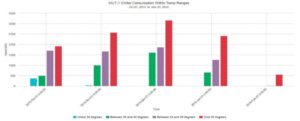Related Case Studies
Read more on how CopperTree Analytics is helping buildings all across the globe create energy savings, improve occupant comfort, and reduce energy consumption with Kaizen.
The Canberra Airport Terminal is renowned for its sustainability and energy efficiency initiatives, winning multiple awards for its leading-edge approach to building design and operation. With nearly 600,000 square feet of terminal building and a 24 hour airport, it was crucial that the new terminal was one of the most carbon friendly in Australia.
This environmentally sustainable development uses a combination of initiatives in water and energy savings. The roof of Canberra’s new airport can harvest a massive 350,000 gallons of water that is used in toilets, air conditioning and landscape irrigation. Energy is saved by the use of two trigeneration plants that produce electricity on site from gas and capture the waste heat to cool and heat the building. This has reduced the building’s carbon emissions by 75% compared to the old terminal facility. Canberra’s new terminal also uses waste recycling, fuel reduction and fully programmable low-energy fittings to reduce its environmental footprint.
After the upgrade of the terminal, focus was turned to operating it as efficiently as possible. CopperTree’s Kaizen analytics Software as a Service (SaaS) was installed to provide Fault Detection and Diagnostics (FDD) and energy monitoring of the airport terminal. Kaizen monitors the building’s operation 24 hours a day, looking for inefficiencies in equipment operation and faults in mechanical systems. After a single day of analysis on all air handling units, it was noted that the economy cycle strategy was operating just off outside air enthalpy, which was highly inefficient for the Canberra climate.
CopperTree Australia’s engineers wrote a new functional description for the economy cycle operation and engaged Delta Building Automation, the HVAC controls contractor on the project, to implement the strategy. The economy cycle strategy was modified to operate off the enthalpy while incorporating an outside air temperature lockout. This new strategy stopped the economy cycle from operating on days over 24°C (75°F) and days under 12°C (54°F).
Although this new strategy was implemented in late January, it has already shown a noticeable reduction in chiller energy consumption. Figure 1 shows the monthly average chiller consumption for days with maximum temperatures of less than 20°C (68°F), between 20°C and 24°C (75°F), between 24°C and 30°C (86°F) and days over 30°C. The consumption between 24°C and 30°C (purple) was fairly steady from October; then a drop occurred in January as there were 10 days of the month with the new strategy operating. A significant drop occurred in February for both temperature ranges as this is was the first full month of the new strategy operation; consumption for days between 24°C and 30°C reduced by 99% and days over 30°C by 78%. This is a dramatic drop in energy consumption and equates to a total reduction of over 70% on total chiller energy consumption.
The effects of poor air handling unit control can have significant implications on the thermal plant energy consumption. It is extremely important that all pieces of equipment work together and do not fight one another to achieve the most efficient system operation. The new economy cycle control strategy has the potential to save in excess of 300,000 kWh per year without a negative impact on occupant comfort.
